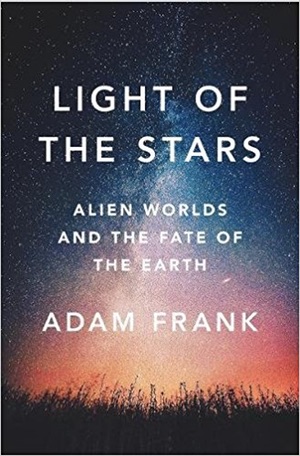Review: Light of the Starsby Jeff Foust
|
| “In other words, what were the chances that ours is the only civilization ever?” he writes. “Putting in the exoplanet data, we found the answer to be 10-22, or one in ten billion trillion.” |
That theoretical confidence that we are not the only civilization in the universe—unsupported, of course, by any actual evidence of extraterrestrial civilizations—is a key element of Frank’s book, which he describes as being about “the astrobiology of the Anthropocene,” the term coined in recent years for a new era where humanity has long-term effects on the planet. If we are not the only civilization, then others have perhaps gone through their own version of the Anthropocene: what lessons do they have to offer to us?
They can’t directly offer us any, though, since we don’t know of any civilizations. Instead, Frank and colleagues developed models of how civilizations grew, and collapsed, based on the use of energy and effect on planetary temperature. In many cases, they found that civilizations suffered massive “die-offs” or full-blown collapses, even in cases where they switched from “high-impact” energy sources (i.e., fossil fuels) to low-impact sources like wind and solar. “In these cases, the planetary environment’s own dynamics were the culprit,” he writes. “Push a planet too hard, and it won’t return to where it began.”
Much of the book is a buildup to this conclusion. Several chapters discuss the Drake Equation and the search for extraterrestrial intelligence, how missions to Venus and Mars helped us understand how planets’ climates can change radically over time, the Earth’s own climate and its feedback with the biosphere, and the search for exoplanets. Those chapters feature a series of vignettes with people involved with spacecraft missions or the research about the study of our own planet and the search for life beyond it.
Ultimately, though, this “astrobiology of the Anthropocene” approach is unsatisfying. There are interesting arguments in the book about the likelihood of intelligent life elsewhere in the universe, and a compelling case that human activities are altering the climate with significant, and deleterious, effects in the years and decades to come. But the combination of the two seems forced and unnecessary. It’s hard to see how models of hypothetical alien civilizations will convince people to take action to protect our own planet. Why not model our own world, which we know infinitely better?
| If we want to preserve our civilization from the Anthropocene, it’s up to us to do so, regardless if we’re the only intelligent species in the universe, or one of trillions. |
There is also, at times, almost an arrogance in Frank’s arguments about alien life. “It’s up to the naysayers to demonstrate how, with so many worlds and so many possibilities over the whole of cosmic space and time, we somehow are the first and the only,” he writes. But that’s not how science works: it’s not up to the “naysayers” to prove a negative—there is no other intelligent life in the universe—but rather for scientists like Frank to find evidence of such life. And, so far, that search has turned up empty: we’re the only life, intelligent or otherwise, known to exist. Perhaps, in the decades to come, we’ll find evidence of past or present primitive life on Mars, Europa, or Enceladus, or biosignatures on a distant exoplanet. Or, possibly, a SETI search will finally find a signal of extraterrestrial origin. However, it’s up to scientists to find that evidence to prove the existence of life beyond Earth, not “naysayers” to prove it doesn’t.
Whether or not other civilizations exist has little bearing on our future. If we find them, it’s unlikely they’ll be landing on the National Mall bearing gifts or transmitting an Encyclopedia Galactica with the solutions to all our problems. And if we don’t—perhaps because the lifespan of those other technological civilizations turns out to be remarkably short—it doesn’t doom our world to the same fate. If we want to preserve our civilization from the Anthropocene, it’s up to us to do so, regardless if we’re the only intelligent species in the universe, or one of trillions. The solution, dear reader, lies not in the stars but in ourselves.
Note: we are temporarily moderating all comments subcommitted to deal with a surge in spam.
